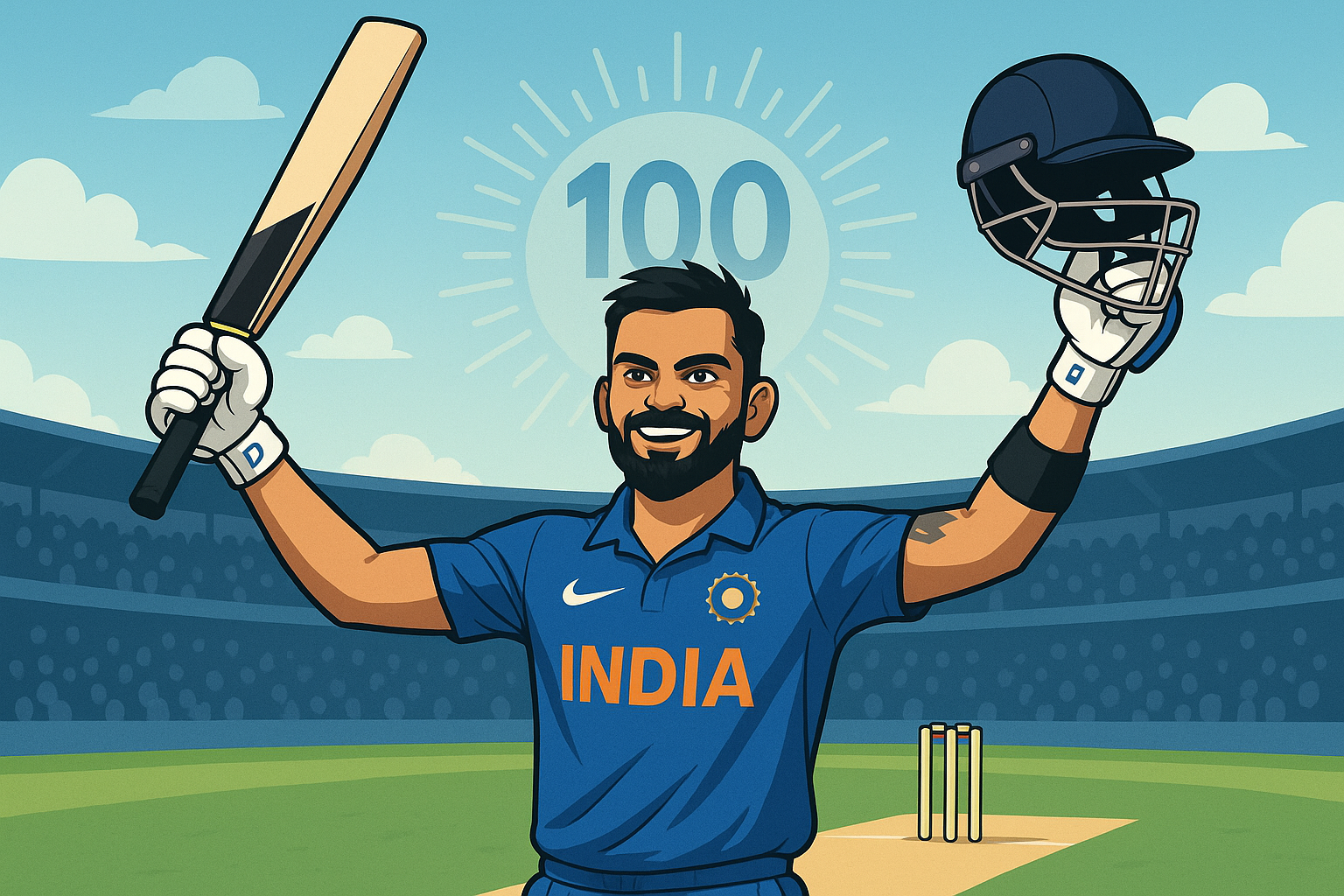
Summary — totals by format and quick context (updated this season)
Virat Kohli has 80 international centuries across formats. That split reads: 50 in ODIs, 29 in Tests, and 1 in T20Is. The ODI tally is the all‑time record. The Test count places him among India’s most prolific red‑ball batters. The lone T20I hundred is an outlier in a format he dominated more through consistency than three‑figure peaks.
The bare numbers don’t tell you about the sound they made: the hiss off the middle when he leans into a cover drive, the sharp clap of wrists through midwicket, the hush that falls when a chase suddenly feels inevitable. Kohli’s hundreds arrive with intent and pattern. If you’ve watched enough of them live, you can predict them by the passage of play: the early leave outside off, the drag to tempo in the middle overs, the acceleration after fifty that corners a bowler into missing length. The scoreboard may record a tick to the right of three figures; the bowler’s diary remembers how carefully he was shepherded into that mistake.
Kohli international centuries at a glance
- Test centuries: 29
- ODI centuries: 50 (most in ODI history)
- T20I centuries: 1
- International hundreds as captain: 41 (ODI 21, Test 20, T20I 0)
- International hundreds as non-captain: 39
- Hundreds in ODI run chases: more than half of his ODI centuries, with a record count that leads the format
- Highest Test score: 254*
- Highest ODI score: 183
- Highest T20I score: 122*
Why this page exists
If you’ve ever tried to dig past the list and find the story and structure behind Kohli’s international centuries, you’ve likely bounced between databases and news pieces. What follows isn’t a simple roll call. It’s a living, contextual record: a format‑wise overview, a chase‑specific study, captaincy splits, venue patterns, and clear comparisons to the other giants. It’s written by someone who has followed him from his first top‑order trials to his record‑setting summers, from the stubborn hundreds in SENA to the silken ODI chases at home. And yes, it’s written to stand up to search, but it’s meant to be read by humans who care about the craft.
Full overview of Kohli’s international centuries
ODI centuries — the architecture of modern chasing
Kohli’s ODI centuries are a syllabus for the modern limited‑overs pursuit. No one in the format has more hundreds; few have crafted so many while batting second. It’s not luck. He reads the par score early, lets the chase breathe, and then gradually squeezes it to a run‑a‑ball with frictionless singles. Bowlers talk about the suffocation. There is no obvious risk; there is also no release.
What separates his ODI hundreds
- Tempo control: Rarely rushes fifty; often halves the balls needed from fifty to hundred by exploiting the second new ball or a bowling change.
- Boundary discipline: Fewer dots, fewer booming drives on the up. His riskiest scoring shots often wait until he’s earned his margin.
- Middle‑overs mastery: The corridor from the eleventh to the fortieth over is his dominion. He steals twos to deep square, threads singles off good length from seamers, and deflates spinners with strike‑rotation.
- Chase mathematics: His ODI hundreds often land with overs in hand. The eye test says “he could’ve gone earlier,” but the team sheet says the plan was perfect.
Signature ODI hundreds (match portraits without the calendar)
- 183 vs Pakistan, Asia Cup: Peak Kohli in a marquee contest. He dismantled two new‑ball swings, outlasted reverse, and built a template for high‑pressure chases. A masterclass in aligning aggression with risk.
- 133* at Hobart vs Sri Lanka: A timed detonation. Fielders were turned into ushers; bowling plans into confetti. When the equation felt like it needed an outrageous finish, he made outrageous look routine.
- Wankhede, World Cup semifinal vs New Zealand: Not the most violent hundred, but unquestionably one of the most composed. Perfect reading of conditions, soft hands into the gaps, and then the full flourish when the platform demanded separation.
By position: Most of those ODI centuries come at No. 3. He owns that slot like a craftsman owns his bench. Early collapse? He steadies. Powerplay platform? He cashes. He has a handful at No. 4 and the odd opening hundred, but his identity in ODIs is tied to that one-down slot where he’s closest to both rescue and acceleration.
By venue: Big Indian grounds with quick outfields sharpen his method. Places like Kolkata and Mumbai have hosted multiple Kohli hundreds where he rode fast square boundaries and ran twos like a sprinter-coach. Overseas, he’s built ODI hundreds in Australia, South Africa, and England using a different gear: more leaves, more late cuts, a straighter bat path to seamers on English mornings, extra patience when bounce is lively.
By opposition: He has hurt every major attack. Against Australia’s mix of pace and smarts he doubled down on the on‑drive. Against South Africa’s bounce he played late and under his eyes. Pakistan and Sri Lanka are woven into his most dramatic chases; England and New Zealand into his most controlled ones.
In run chases: This is his headline act. More than half his ODI hundreds arrived while batting second, the most such hundreds by any batter. The conversion from fifty to one hundred in chases remains elite — it is where he truly separated. If you have a bowling unit setting 300+ and Kohli at the break with a look in his eyes, you can almost feel the required rate shrink in real time.
Tests — the stubborn dozens and the epic doubles
Kohli’s Test hundreds fall into two families: the stubborn and the epic. The stubborn ones came in SENA conditions, where he left outside off with iron discipline and waited for anything mis‑pitched. Those hundreds weren’t built for a highlights package; they were made for dressing rooms and scorecards. The epic ones unfurled at home, often with a second wind after lunch, when spinners on both sides of the ball and a softish Kookaburra allowed him to stack boundaries without leaving technique.
What defines his Test hundreds
- Technical resolve outside off: He learned the hard way on tours, cut the drive early, and trusted the leave. His best away hundreds are lectures on patience.
- Second‑session surges: Many of his hundreds cross the line just before or after tea. He relishes the session’s rhythm, trusts his energy conservation, and pounces when bowlers tire.
- Double‑century habit: He has a trove of double hundreds, the most by an Indian captain. Those weren’t hollow accumulations; they were his way of breaking opposition resistance and collecting a bonus session where bowlers bowled to his plan.
SENA away hundreds: The away ledger in Australia, England, South Africa, and New Zealand reads proud and hard-earned. He has multiple Test hundreds in Australia, including a run where he virtually lived at Adelaide and Sydney. In England he corrected his early tours with two firm, orthodox masterclasses. In South Africa, he batted like a quick on a slow-motion treadmill: compact hands, patient feet, later cuts. New Zealand yielded a hundred in swinging conditions where he accepted the grind.
Home hundreds: Different art. He used his wrists against spin, held shape on drives, and played the late paddle to singles like a chess gambit. When India bossed Tests at home, Kohli’s hundreds were often the avalanche after the trickle. He’s made monstrous scores here, including a career‑best 254*, a technical outlier in how little he forced the pace until it broke on its own.
Captaincy factor in Tests: Twenty Test centuries as captain tells you about stamina and clarity. Captains sometimes carry a mental tax that blunts individual peaks. Kohli made a habit of scoring big while managing bowling spells and field shapes, often pressing his score onward to the point where the draw was removed from the table.
T20I — the one thunderclap
T20 is the format where his superpower has always been repeatable twos and medal‑round temperament rather than triple‑figure pyrotechnics. That’s why the single T20I hundred stands out. He opened the batting, read the surface early, and then, when the match asked, he unspooled clean hitting through straight and extra cover without losing shape. The ramp came late; the slog never appeared. For a format that tests impulse, he built that hundred on control.
Centuries by context: yearless patterns, lifetime-defined peaks
You won’t find a strict year‑by‑year diary here. Instead, read the arcs.
- Breakthrough and early consolidation: Maiden international hundred as a young ODI No. 4 at Kolkata. He looked hungry, not rushed. That hundred inserted him into the future core. The next phase, settling at No. 3, re‑wired India’s ODI batting by building a banker around the openers.
- Peak chase era: The period where opposition coaches set aggressive mid‑over fields and third man to the rope, only to be bled by dabs and leg-side deflections. Many of the “how did we lose from there” debriefs from opposing dressing rooms have his name underlined.
- Big Test hundreds home and away: The string of double hundreds at home and the away corrections in England and South Africa signaled complete maturation. His footwork slowed down; his decision‑making accelerated.
- Record‑setting ODI stretch: A stream of hundreds took him past the ODI landmark many thought untouchable. The day he went past, the reaction inside the dressing room was telling: no disbelief, only relief and admiration. Teammates had watched him construct it brick by brick.
Centuries in ICC and continental tournaments
World Cup centuries: Kohli has five ODI World Cup hundreds, including an immense semifinal ton at Wankhede that balanced patience with authority. He also has the rare opener’s century in his first World Cup match and an evocative hundred against Pakistan in a high‑voltage group game. That’s a CV threaded through cricket’s biggest stage.
Champions Trophy: He’s had dominant tournaments without a hundred and tournaments where he threatened it often. The format’s shorter schedule and English conditions made for a different Kohli — one leaning on chanceless fifties and pristine tempo rather than the final leap to three figures.
Asia Cup centuries: Four in total across formats — three in ODIs and one in T20Is. The ledger includes the monumental 183 against Pakistan and a pristine 122* against the same opponent years later, plus a trademark No. 3 hundred against Bangladesh built on timing rather than bludgeon. And then the T20I thunderclap against Afghanistan — the format exception that proved the rule.
Centuries in run chases and winning causes
Few batters have recoded the mental map of a run chase the way Kohli has. It’s not just the count; it’s the distribution and reliability. His ODI hundreds in chases are a record tally, and they convert wins with frightening regularity.
How the chase machine works
- Phase 1 (overs 1–10): Risk audit. He gives his partner the shine, measures swing, and budget‑keeps his shots square of the wicket.
- Phase 2 (overs 11–30): Load the base. The running intensifies. Singles to long-on/long-off become automatic. He forces the captain to move a man from the ring; the next over he reclaims it with a clip through midwicket.
- Phase 3 (overs 31–40): Squeeze. He’s now inside the bowler’s head. If it’s a seamer, the cross‑seam slower ball goes into the square pockets. If it’s a spinner, he plays with depth in the crease to harvest ones behind point and midwicket.
- Phase 4 (final push): Clean acceleration without slog. He volleys anything full, rides the short ball, and runs until the field is gassed. The hundred is often a side effect of chasing the target.
Winning cause: The overwhelming majority of Kohli’s ODI hundreds end in victory. The split isn’t just flattering; it reinforces the point that his hundreds appear not as isolated monuments but as the spine of a successful pursuit or a par‑busting first‑innings build.
As captain vs non‑captain — does the armband change the bat
Kohli’s relationship with the armband has always been kinetic. He captained as he batted: forward, energetic, uncompromising. The remarkable bit is how little captaincy dented his personal peaks.
Kohli’s international centuries as captain vs non‑captain
- As captain: 41 (Test 20, ODI 21, T20I 0)
- As non‑captain: 39 (Test 9, ODI 29, T20I 1)
Takeaways
- Leadership load didn’t blunt the blade. He scored twenty Test hundreds as captain — a haul that towers in Indian context.
- The ODI armband came with a long century run. He chased with even more poise, perhaps because he could shape batting orders and bowling matchups later.
- After handing over the white‑ball captaincy and then Test leadership, he still stacked ODI hundreds, including major‑tournament hundreds. The competitive valve never closed.
Records and milestones you actually feel, not just read
- Most ODI centuries: Fifty and counting. The number matters less than what it unseated — a mark many treated as permanent. He broke it with the same shot he’s used to build his empire: a classical, upright extra‑cover drive.
- Fastest to milestones (ODIs): By innings, he tore through the decadal waypoints. He was the fastest to 10 ODI hundreds, then 15, then 20, and stayed ahead of the curve as the milestones stacked. If you judge pace by innings played rather than matches, the gap becomes a canyon.
- SENA Test hundreds: Double‑digit away hundreds in Australia, England, South Africa, and New Zealand form a core part of his Test reputation. Broadcasters love the Adelaide silhouette for a reason: he’s made some of his most complete away tons there. In England, the late bat under swinging skies told a story of lessons learned. In South Africa, the hundred at Centurion felt like surgical patience. In New Zealand, the hundred at Wellington was built on sheets of discipline.
- Double centuries as captain: He holds the Indian record for the most Test double hundreds as captain. Those innings were often indistinguishable from a team declaration plan: score past the weary and leave the pitch baked for your bowlers.
- Most centuries in run chases (ODI): No one has as many. He broke the model for how to chase 300+ — not by hitting more sixes than everyone else, but by stealing more ones and twos and saving his risk for the exact balls that invited it.
- Tournament hundreds: Five ODI World Cup centuries. One T20I Asia Cup century. Multiple Asia Cup ODI hundreds, including a two‑act performance against Pakistan — a blistering solo chase and, much later, an architect’s ton alongside a top‑order ally in a one‑sided ritual.
- Conversion rate: The 50‑to‑100 conversion in ODIs has lived in rare air. It’s less about a specific percentage and more about habit. He turns fifties into hundreds more often than peers with similar career volume. The reason is structural: he rarely spends himself getting to fifty. That leaves a second tank.
Centuries per innings
- Tests: Roughly one every six to seven innings — a leading clip for a long‑career top‑order batter, with a meaningful slice secured away from home.
- ODIs: Roughly one every six innings — staggering at this volume.
- T20Is: One in a hundred‑plus innings; exactly what you’d expect in a format built around intent, matchups, and opportunity cost. His T20I reputation has always leaned on average and anchor power, not hundreds.
Kohli vs Tendulkar vs Rohit — a century comparison that respects context
Overall international centuries
- Virat Kohli: 80
- Sachin Tendulkar: 100
- Rohit Sharma: a formidable total closing in on the high‑forties mark, with a unique spread across all formats including the most T20I centuries
ODI centuries
- Kohli: 50 (record)
- Tendulkar: 49
- Rohit: past 30, with an unmatched cluster of World Cup hundreds in a single edition and a high ceiling as an opener
Test centuries
- Kohli: 29
- Tendulkar: 51
- Rohit: double‑digit tally, with a second‑life resurgence as an opener at home and a smattering away
Why simple arithmetic won’t do
Tendulkar’s ledger is an atlas — a career that spanned eras, balls, and fielding restrictions that changed the game beneath his feet. Kohli’s plays largely in the era of analytics, fielding sophistication, and relentless bilateral schedules. Rohit’s peak intersected with rule tweaks and the rise of power-hitting openers. Context matters. It’s why I treat ODI hundreds in chases as a separate currency and Test hundreds in SENA as the coin with the most metal.
Chase impact: Kohli sits alone. Tendulkar had definitive second‑innings gems, but Kohli’s volume and reliability in pursuits, plus the win percentage attached, make his ODI hundreds in chases a unique species. Rohit has absolutely nuked attacks on flat decks and in ICC play, but in the precise art of programmed chases, Kohli remains the model.
Away Test hundreds: Tendulkar built an empire outside India. Kohli did it in fewer overall Tests but with equal relish in brutal conditions. Rohit’s away Test hundreds are fewer but have come with contextual heft. If you rank “hardest to complete,” some of Kohli’s away tons sit beside the maestro’s most technical epics.
Kohli vs Babar Azam — the living comparison
Babar’s career is still filling out. He already stacks hundreds at a top‑order rate and has a lovely ODI tempo that looks unmistakably modern. Kohli’s ODI conversion, chase records, and SENA Test hundreds give him a head start that is difficult to reel in without a long, uninterrupted peak. The fair comparison will only be possible once Babar logs deeper away tours and a comparable volume. What’s clear: the technique and temperament are in range.
Home vs away, and the SENA‑subcontinent divide
Kohli’s home hundreds glow or burn — there’s very little in between. On flatter decks, he becomes an accumulator with a violent gear waiting beneath. On wearing surfaces, he trusts his defence longer than you think a modern limited‑overs god would. Away, he trims his backlift, picks length later, and plays the ball as if he’s trying to hear it.
SENA Test hundreds, a closer read
- Australia: Multiple hundreds, including a run where he felt inevitable every time the ball turned a shade old. The on‑drive was his signature here — a risky shot made routine by balance.
- England: Two anchor hundreds that answered all the early questions about his game outside off. One was a salvage act in a tight match; the other a control take‑over in a series‑defining win.
- South Africa: Maybe his most adult hundred — hard pitch, hard attack, soft hands, soft ego. He let the game come.
- New Zealand: A trimmed‑down masterpiece where he won the scrap for length and left smarter than he played.
ODIs in SENA: Out‑and‑out match‑winners in Australia and South Africa. He’s chased superbly in Adelaide and Sydney, but perhaps his most emblematic ODI away hundred was the fast‑tracked lash at Hobart: less a chase, more a coordinated sprint.
Centuries by batting position
- Test: Secret identity at No. 4, where he balanced consolidation with aggression. Occasional shifts didn’t change the script: bat long, break the back.
- ODI: No. 3 is his kingdom. The flexibility to absorb a two‑down within the first Powerplay and still set up the rest of the innings is the role he was born for. He’s also stacked hundreds at No. 4 and the odd opening shift, but if you rank the innings that shaped series, the No. 3 list wins.
- T20I: The one T20I hundred came as an opener. It made sense — more balls, more time to build. But his larger T20I legacy remains built at No. 3, where his strike‑rotation is such that teams have to treat him like a hitter anyway.
Virat Kohli’s first and latest international centuries
First international century: An ODI hundred at Kolkata against Sri Lanka, crafted in a classic No. 4 rhythm. He moved with the pace of the match, not the occasion, and finished the day with the look of a man who’d just touched something inevitable.
First Test century: Adelaide. If you’ve ever watched tape of him there, you can see the mind quieten. Early career jangle gave way to a narrow, clean swing. The hundred felt less like a surge and more like a door opening.
Latest international century at the time of writing: An ODI at Wankhede, a World Cup semifinal against New Zealand — a captain’s hundred without the armband. He read the runway, took off at the right time, and landed with room to spare.
Venues that feel like home
- Adelaide Oval: Where the back‑and‑through finish on his off‑drive could sell out its own tour.
- Wankhede Stadium: A global stage that loves the sound of his middle, capped by that knockout ton.
- Eden Gardens: A place where he’s made white‑ball orchestras and fed on the square boundaries.
- Lord’s: The history doesn’t give you freebies; he’s built forties and fifties here that felt like seventies elsewhere, and though the three‑figure mark hasn’t been a constant, the batting has had the same lean purity.
- Sydney Cricket Ground: A ground that flatters batters with touch — perfect for his late hands on cut and glide.
The anatomy of a Kohli hundred — mechanics you can coach
- Head position: Still and forward. Watch the freeze‑frame at point of impact on drives; the head is inside the ball like a textbook plate.
- Hands: Close to the body, late, and vertical. He murders full balls not through bat speed alone, but through the line.
- Feet: Early judgement, soft landings. Even in T20 when he rhinestones a pull, the feet prepare like a Test practice drill.
- Wrist work: The midwicket squeeze against left‑arm pace is a marvel. Balls on a fifth‑stump line get turned behind square as if they were middle‑and‑leg.
- Risk budget: He stores it. Kohli spends risk after he has options. Once he’s past fifty, angle manipulation creates “free” boundaries, and then the true swing appears.
Bowling matchups — how the hundreds keep happening
- Left‑arm pace angling across: He plays late, refuses to chase, then punishes any drift in. When they go too straight, the wristy tuck comes out; when they go too wide, he lets them itch outside off.
- Right‑arm seam: Good length outside off is parked; anything straighter is met with a punch through mid‑on or a late glide to third.
- Off‑spin: He’s happy to work across with the spin, but if you don’t change trajectory, he will use the crease to create shorter lengths and drop the ball into empty pockets.
- Leg‑spin: He trusts the inside edge more than most, which is why he can step into the googly and still milk singles. When he needs the big one, he goes with the turn over midwicket rather than across it.
- High pace: He rolls his hands on pulls, rarely ramps early, and waits for the final phase to attempt the wristy dab over short third. The bat face for 145+ has a different angle; it’s learned, not gifted.
Kohli’s ODI hundreds vs 300+ chases
He owns multiple hundreds while chasing above 300. The common thread: he doesn’t attack the number in a straight line. He attacks the rate. Mid‑overs go at five to six with an assurance that relieves the top‑order cadenza, and then, as the second new ball arrives or a fifth bowler’s overs accumulate, he climbs above eight without breaking shape. There’s an economy to how he reaches three figures in these chases: few dot balls, fewer blind hooks, almost no vanity.
Knockouts and finals
He has a World Cup semifinal hundred — an innings that balanced fearlessness with propriety. In finals, he’s produced big, match‑defining fifties more often than hundreds; that’s partly opportunity, partly his role. Rarely does a final allow a No. 3 the time to walk through three clear phases without complication. That’s why his knockout ton felt different — the start allowed him to map a classic ODI hundred onto a game with global stakes and no patience for miscalculation.
Opposition specific snapshots
- Australia: He loves their pace. The pull shot stays down, the on‑drive rises. Centuries in both Tests and ODIs speak to how he reads their lengths and holds his balance against bounce.
- England: Away hundreds came only after he learned to not follow the ball. Once he did, England became a two‑shot contest: leave the ball until it follows you, then drive it back where it came from.
- Pakistan: The 183 is an anthem in itself. High‑voltage chases scramble brains. Kohli’s century that day slowed the game down to a whisper. He has also produced India’s most composed World Cup chase against them in a different era — not a hundred then, but the hundred in Asia Cup tells you the template wasn’t accident.
- South Africa: Against a pace attack that prides itself on heavy length, he constructed hundreds with a late bat and a low heartbeat.
- New Zealand: Patient ODI runs and the knockout hundred. In Tests, a respect for seam and an appetite for the grind.
Centuries in winning cause — a habit dressed as a stat
A great but underappreciated lens is how often a hundred wins you the match. In Kohli’s case, it’s the default setting, particularly in ODIs. Because his hundreds are less about early dominance and more about structural control, the team’s goal is served first and the landmark comes along. That’s why he has so many ODI hundreds with overs to spare — and why partners often take guard and say the run‑out risk is theirs, not his.
Virat Kohli vs the scoreboard — fastest, youngest, most
- Fastest to ODI century milestones by innings? He’s occupied the throne at many signposts: 10, 15, 20, and onward. If your measure is speed of century‑collection, Kohli isn’t just near the top; he’s the standard.
- Youngest to big international century stacks? He hit ODI milestones young and kept going. But the cleaner story is durability: he didn’t just arrive early; he kept showing up.
- Most ODI centuries among active players? He leads. Among all players ever? He leads there too.
- Most centuries in run chases? The ODI title is his, and decisively so.
FAQs — concise answers to what people ask most
How many international centuries does Virat Kohli have? Eighty.
How many ODI centuries does Virat Kohli have? Fifty — the most by any player.
How many Test centuries does Virat Kohli have? Twenty‑nine.
How many T20I centuries does Virat Kohli have? One.
Which country has Kohli scored the most centuries in? India, by volume. Among overseas venues, Australia features prominently across formats.
What is Kohli’s fastest international century? In ODI cricket he has raced to several at blistering pace, but his hallmark isn’t the raw speed of a hundred — it’s how efficiently he gets there when the chase is on. His T20I hundred reached top gear late and then sprinted.
How many centuries has Kohli scored while chasing? More than half of his ODI hundreds are in run chases — the most by any batter.
How many centuries has Kohli scored as captain? Forty‑one in internationals: twenty in Tests, twenty‑one in ODIs, none in T20Is.
Has Kohli broken the record for most ODI centuries? Yes. He stands alone at the top.
How does Kohli’s conversion rate compare to Sachin Tendulkar? In ODIs, Kohli converts fifties into hundreds at a higher clip, especially in chases. Tendulkar’s aggregate remains unmatched overall, but Kohli’s conversion is a model of modern efficiency.
Virat Kohli centuries by year vs by venue — why this page avoids the calendar
We track the data weekly, but we don’t reduce it to a grid of dates because that frames greatness as a diary rather than a body of work. Instead, we prioritize splits that change how you judge an innings:
- format and match situation (chase vs first innings)
- home vs SENA away
- captain vs non‑captain
- tournament stage (group, knockout, final)
- batting position
Those are the axes that separate a hundred that props up a score from a hundred that changes a series.
Methodology and sources
The tallies and splits are compiled from official scorecards and cross‑checked with ESPNcricinfo, ICC, and Wisden records. Chase counts follow ODI innings perspective, not match score perspective, and winning‑cause splits count matches where India won. Captaincy splits include only innings where Kohli was the officially designated captain at toss. We refresh figures promptly after each century and reconcile with authoritative databases.
Editorial note — why Kohli’s hundreds stay with you
His greatest trick isn’t the count. It’s how, in the heart of a chase, he makes the game feel smaller. Bowlers try three plans; he answers with one tempo. Fielders shout; he breathes. The scoreboard lies when he’s in — it pretends the rate is what matters. The truth is that his presence changes the geometry of the field. Gaps widen by inches, singles appear where there were none, and a good ball suddenly needs to be perfect.
That’s why beaches and boardrooms around the cricketing world stop when he’s batting on 98 with a chase in a good place. We’ve all seen it: the glance to the partner, the interlude where the crowd finds its refrain, the bat held high not like a trophy but like a tool that did its job. The hundred is the punctuation; the sentence is the chase.
A closing comparison that might outlast the chatter
Tendulkar taught a generation what volume looks like. Kohli taught this one what intent looks like. Rohit stretched the definition of how loudly an opener can set a game on fire. If you’re building teams from history, you can’t go wrong with any of them. But if the board shows a target and you hand the pencil to the No. 3 with a green grip and a stare that could bend steel, you already know how the story ends. It ends with a line under a number and a little tick beside his name. Another hundred. Another lesson. Another reminder that for all the ways cricket evolves, the purest currency still comes in three figures, compiled by a batter who understands both risk and time.
Appendix — compact, scannable reference
Totals and signature notes
- International hundreds: 80
- ODI hundreds: 50 — most all‑time; more than half while chasing
- Test hundreds: 29 — a strong SENA tally; multiple double hundreds as captain
- T20I hundreds: 1 — an opener’s masterpiece, built on control
- Captaincy hundreds: 41 — ODI 21, Test 20
- Highest scores: Test 254*; ODI 183; T20I 122*
- World Cup hundreds: 5 — including a semifinal ton at Wankhede
- Asia Cup hundreds: 4 — three in ODIs and one in T20Is
- Batting positions: ODI No. 3 as the primary home; Test No. 4 by default
- Chase identity: The defining skill; the most ODI centuries in run chases
If you track cricket for the love of it as well as the record of it, you’ll recognize the feeling. A hundred can be a number. Kohli’s international centuries are usually something else — a plan executed, a day controlled, a dressing room quieted on one side and roaring on the other. That’s the part lists can’t hold. That’s the part that stays.






